Delidding The AMD Ryzen 5 2400G APU: How To Guide and Results
by Gavin Bonshor on May 10, 2018 8:00 AM EST- Posted in
- CPUs
- Guides
- APUs
- Ryzen
- Ryzen 3 2200G
- Ryzen 5 2400G
- Delidding
- Delid
Delidding The Ryzen 5 2400G Results and Conclusion
There has been a lot of hype since the launch of the Ryzen 2000 series APUs and in our Ryzen 5 2400G review, it’s noted that in multiple scenarios they outperform the competing Intel counterparts second to none in pixel rendering tests such as gaming, mainly thanks in no small part to the integrated iGPU featuring Vega cores. The aim of today’s testing with our best Ryzen 2000 series APU from a purely CPU frequency-based standpoint was to ascertain whether delidding makes a noticeable improvement to thermal performance, as well as determining if any extra headroom in CPU core frequency is made available.
As per our regular motherboard testing methodology when we find the max stable overclock, testing was done following the same procedure. Following on from the testing done in our Ryzen 2000 series APU overclocking guide, the aim in this was to continue with simple overclocking to push the core frequency.
To start, here are our initial overclocking results with the retail chip as sold:
After delidding the chip, replacing the paste with a liquid metal TIM, we achieved the following results:
Not only are the thermal properties improved from delidding and having the IHS slavered up with Thermal Grizzly Conductonaut liquid metal compound but operating at the previously unstable frequency of 4.2 GHz was made possible after delidding. Even at 4.2 GHz with the 2400G delidded, the temperatures hit the same levels as 4.0 GHz non delidded which is quite impressive. Even more monumental was the system managed to boot into Windows 10 at a clock speed of 4.3 GHz, although the system wouldn’t just hang when OCCT was fired up, it would crash completely meaning that even with a good AIO CPU cooler and being de-lidded, no more than 4.2 GHz was stable with this particular chip.
The best way to represent some of this data is in graphs. First up is the main one, temperature:
This is a clear representation showing the decrease in CPU temperature after the delidding process. The higher the frequency, the bigger the overall difference!
For power consumption, there was almost zero difference. This is to be expected: the chip will still consume the same amount of power with a standard temperature window. The cooler still has to remove the heat energy, however it is now being transferred better to the cooler through the new TIM.
The interesting result here is POV-Ray. We use POV-Ray in our overclock testing as it is usually very good if there are cache and memory errors associated with the high frequency. However here we see that beyond about 3.8 GHz, the retail processor has trouble getting more performance at a higher frequency, likely due to the CPU reaching thermal limits and the frequency mechanisms having to compensate. The end result is 'sustained' performance at higher frequencies. Due to the delid process, this was not an issue through to 4.2 GHz. Having the extra thermal headroom ultimately gave both more frequency and better sustained performance.
Is Delidding the Ryzen 2400G Worth it? Risk Versus Reward
As previously stated, the primary use where I could see delidding a Ryzen 2000 series APU viably applicable would be in a situation where cooling restrictions are in place such as a small form factor system or a HTPC. The benefits of the reduction in temperature would allow for a more svelte and slim line cooler to be used without pushing towards the maximum operating temperature.
Another less but pertinent use would be for performance users wanting faster clock speeds, although at a cost of voiding the warranty, potentially damaging and killing the chip itself during the process, and the added cost of the tools, it could be a price too much in retrospective which could be spent on a better CPU to begin with. Some vendors in the EU such as Caseking are actually selling pre-delidded Ryzen 3 2200G and Ryzen 5 2400G chips with their own warranties at an additional cost, which is often a better idea than manually performing the process and shelling out for the extra tools. That’s all good, providing this option is available to the user, although so far, I have yet to be able to find a large vendor offering this service in the US.


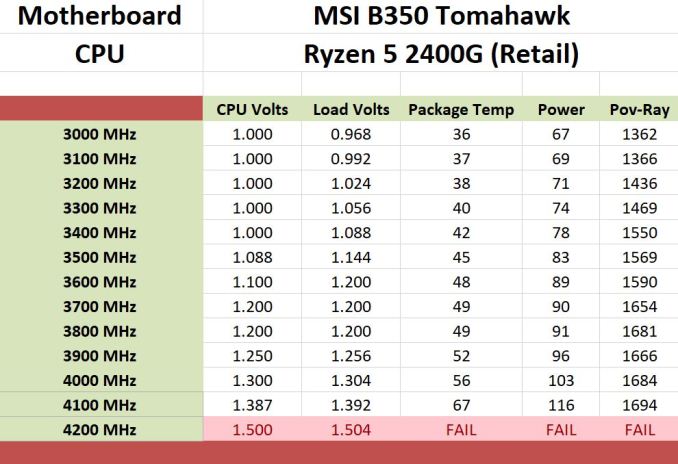
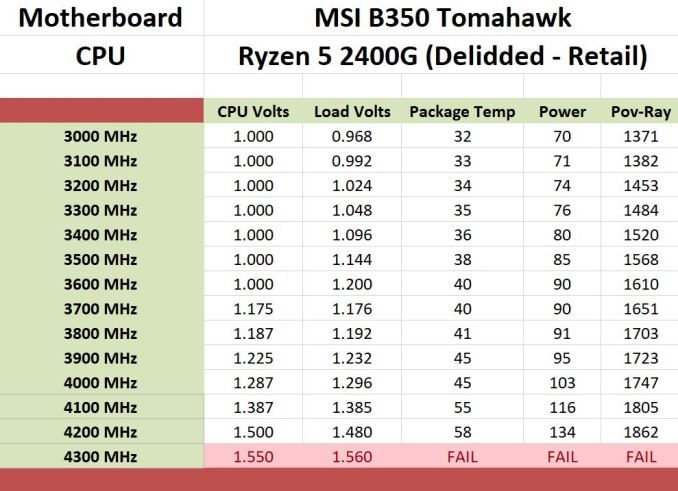
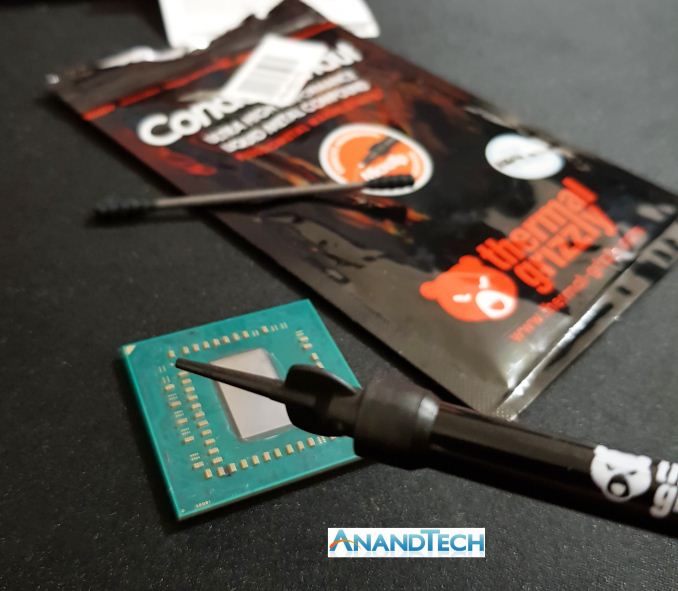
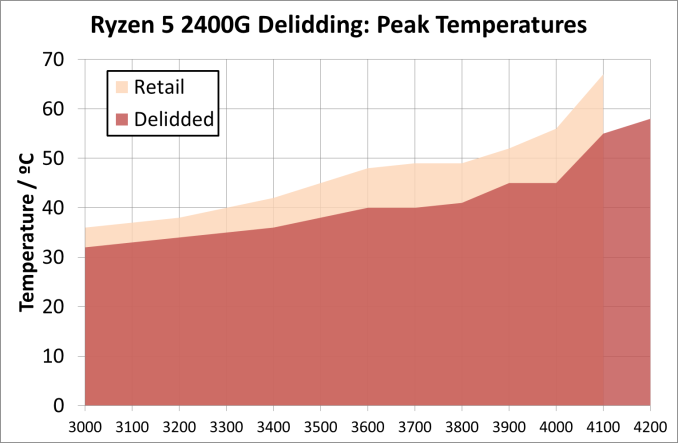

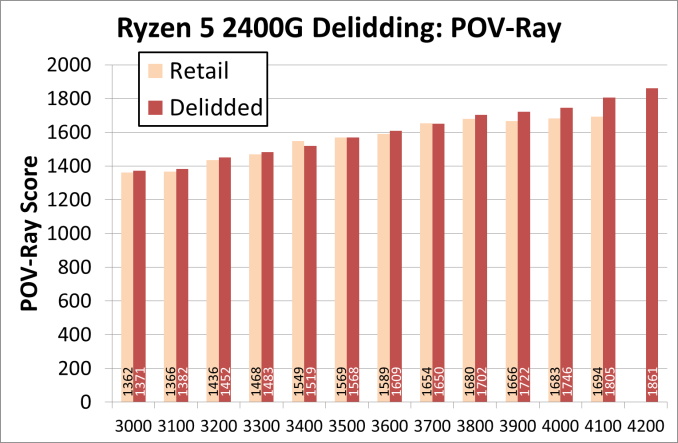








73 Comments
View All Comments
Oxford Guy - Thursday, May 10, 2018 - link
Properly-formulated and applied solder is irrelevant when it comes to "crack risk" unless you're using extreme cooling like nitrogen. If it's not properly-formulated, though, there can be a problem. That's what happened when Nvidia released a lot of mobile GPUs that failed. Apple was nice enough to replace the defective boards with defective boards. The industry doesn't do real customer service, like recalls.nathanddrews - Thursday, May 10, 2018 - link
In this chart, you show the stock/retail chip consuming 132W at 4.2GHz, but I think that is an error because the other charts don't show it capable of reaching 4.2GHz. Is this correct?https://images.anandtech.com/doci/12640/Delid%20Po...
gavbon - Thursday, May 10, 2018 - link
Each test bed is different, the chip used in this piece was a second Ryzen 5 2400G sample that could achieve this. The original sample from the review Ian published couldn't attain; I have both the launch samples and a pair of newer retail samples from AMD which we used all 4 in the overclocking piece: https://www.anandtech.com/show/12542/overclocking-...Ian Cutress - Thursday, May 10, 2018 - link
We can take a power reading at say 30 seconds, but it might not be stable for a full 5 minutes load.medys - Thursday, May 10, 2018 - link
Is there a reason for installing the lid back on the cpu?Why not install heat sink straight after deliding?
gavbon - Thursday, May 10, 2018 - link
The CPU cooling plate wouldn't sit flush on top of the die. This is why companies such as EKWB make 'naked die' mounts for their water blocks. When removing the IHS completely, what you're essentially doing is adding clearance between the CPU cooler and the die.To make it sit flush, you would need the cooler to screw closer in as to actually make contact. Too much pressure on the die however will crack it which = dead APU/CPU
Lord of the Bored - Friday, May 11, 2018 - link
BRING BACK THE THUNDERBIRD SHIMS!...
No, seriously. That's exactly why we had shims. Bare die for better cooling, but a greatly reduced crush risk.
nathanddrews - Friday, May 11, 2018 - link
They still exist, but they're called "direct die frames".Foeketijn - Wednesday, May 23, 2018 - link
There are a lot of Pentium 3/AMD Athlon/AMD Duron/AMD Athlon XP's that would disagree. In the 2k I messed around with a lot of Athlon XP's and where not carefull at all. Yes, I scratched and chipped a lot of chips while soldering pins and spots to unlock special features. But they tended to keep on working as normal.eastcoast_pete - Thursday, May 10, 2018 - link
Interesting article, thanks! The thing I don't get is why AMD, trying to gain market share from chipzilla, wouldn't spend the extra cents per chip and use the solder instead of the paste to begin with. Heck, they could even make it part of their marketing: they use gooey paste, we use quality solder.On another note, as they provide a stock cooler: are there any systems out there that do away with the lid entirely, and go straight to something like a vapor chamber approach in a sealed setup? Is this what they do for the Xbox X?